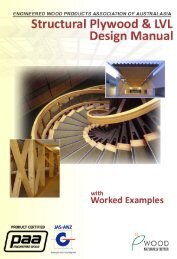Facts About Particleboard and MDF - Engineered Wood Products ...
Facts About Particleboard and MDF - Engineered Wood Products ...
Facts About Particleboard and MDF - Engineered Wood Products ...
You also want an ePaper? Increase the reach of your titles
YUMPU automatically turns print PDFs into web optimized ePapers that Google loves.
Moisture Properties<br />
Board dimensions are closely related to moisture content <strong>and</strong> the effect of long exposure to high humidity<br />
conditions may give rise to problems where close tolerances are required. <strong>Particleboard</strong> should be<br />
conditioned to reach equilibrium with the humidity level in which it is to be used. Moisture content will<br />
normally be in the range of 10-12% when used in air-conditioned buildings.<br />
For other buildings, boards may require conditioning to higher or lower moisture contents with the range<br />
possibly covering 6-14%. This conditioning is important where close tolerances are required.<br />
Measurement of moisture content may be achieved by weighing <strong>and</strong> drying or by using an electric moisture<br />
meter.<br />
MR <strong>Particleboard</strong> is intended for use in areas where there is continued high humidity conditions or the<br />
occasional risk of wetting. Despite careful attention to performance after exposure to water, MR<br />
<strong>Particleboard</strong> should not be used in circumstances where continued wetting is likely. If the board is<br />
continually wet, degradation may occur through glue bond breakdown <strong>and</strong> through fungal attack.<br />
Absorption <strong>and</strong> Swelling<br />
MR <strong>Particleboard</strong> exhibits much slower response to wetting than does St<strong>and</strong>ard <strong>Particleboard</strong>. While<br />
thickness swelling <strong>and</strong> residual swelling after drying out are also much lower, the slow response rate is a<br />
major practical advantage in minimising moisture effects. Residual thickness swell should be unnoticeable<br />
unless the board receives a prolonged soaking.<br />
Permeability to Moisture Vapour<br />
Moisture vapour will slowly permeate <strong>Particleboard</strong>; a typical figure for 13 mm MR <strong>Particleboard</strong> is 4.6 x 10 2<br />
g/m 2 mmHg.<br />
Dimensional Changes<br />
When MR <strong>Particleboard</strong> is exposed to changing relative humidity conditions -<br />
Linear dimensions will change about 0.03 - 0.06% for each 1% change in moisture content.<br />
Thickness change will be about 0.03 - 0.5% for each 1% change in moisture content.<br />
H<strong>and</strong>ling <strong>and</strong> Storage<br />
Although these boards are defined as moisture resistant, there is a likelihood of some swelling in thickness<br />
<strong>and</strong> change in dimensions if they are exposed to the elements for protracted periods. Care should therefore<br />
be taken to ensure that boards are not neglected in storage or on site. Planners should make the same<br />
considerations <strong>and</strong> take the same precautions with MR <strong>Particleboard</strong> as they would for St<strong>and</strong>ard<br />
<strong>Particleboard</strong>.<br />
14

















